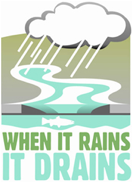Stormwater Pollution
What is Stormwater?
 Stormwater runoff occurs when precipitation from rain or snowmelt flows over the ground. Impervious surfaces like driveways, sidewalks, and streets prevent stormwater from naturally soaking into the ground.
Stormwater runoff occurs when precipitation from rain or snowmelt flows over the ground. Impervious surfaces like driveways, sidewalks, and streets prevent stormwater from naturally soaking into the ground.
 Stormwater runoff occurs when precipitation from rain or snowmelt flows over the ground. Impervious surfaces like driveways, sidewalks, and streets prevent stormwater from naturally soaking into the ground.
Stormwater runoff occurs when precipitation from rain or snowmelt flows over the ground. Impervious surfaces like driveways, sidewalks, and streets prevent stormwater from naturally soaking into the ground.
In November 2002, the Board of the Department of Health and Environmental Control appointed the 19 members of the Council on Coastal Futures as an ad hoc advisory committee. The Board charged the council with documenting priority issues and concerns and recommending actions, programs and measures to improve the effectiveness of the South Carolina Coastal Zone Management Program.
In 1986, a Blue Ribbon Panel was convened by the former South Carolina Coastal Council (now SCDES-BCM) to address what was considered a "crisis" situation involving our beaches.
Most beaches in South Carolina go through a yearly cycle of profile change. In the summer, smaller waves tend to push sand up the beach, forming a wider berm and a steeper beach slope below mean high water. In the winter, higher energy waves erode sand from the berm and move it to an offshore bar, resulting in a narrower high-tide beach and a more gently sloping beach below mean high water.
Department staff had initially considered including revisions to address narrative flow standards during the 2022 triennial review. However, staff determined more stakeholder involvement was necessary to evaluate appropriate revisions to narrative flow standards. Therefore, a separate regulatory promulgation process to specifically address this issue was initiated by the Department in July 2022.
The EPA provided the Department with several recommendations to consider during the triennial review in a letter sent to the Department on August 3, 2021.
The Notices of Drafting for the 2019 triennial review of Regulation 61-68, Water Classifications and Standards, and Regulation 61-69, Classified Waters, were published in the State Register on Friday, February 22, 2019. The closing date for the public comment period was March 25, 2019.
Swimming in the ocean is an excellent outdoor activity for the whole family. However, any outdoor activity has its own set of safety issues that we should all plan for and recognize. When coming to the beach you will want to bring sunscreen, a beach towel, beach shoes, and perhaps an umbrella.
During the Spring and Summer of 2020, the Surface Water Withdrawal Permitting program hosted a series of stakeholder meetings to assess the state of the safe yield calculation and explore the possibility of better methods to be used when determining safe yield for rivers and streams. The final summary report and Department conclusion of this stakeholder process is available below: